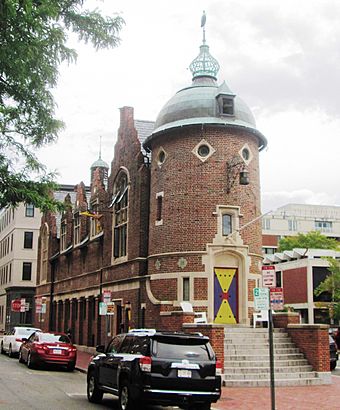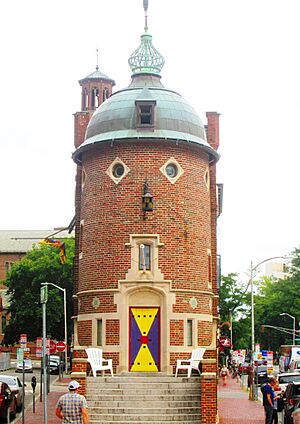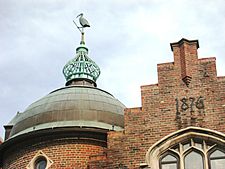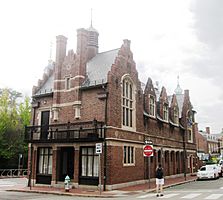Harvard Lampoon Building facts for kids
Quick facts for kids |
|
|
Harvard Lampoon Building
|
|

(2017)
|
|
| Location | 44 Bow Street Cambridge, Massachusetts |
|---|---|
| Built | 1909 |
| Architect | Edmund M. Wheelwright |
| Architectural style | Mock Flemish |
| NRHP reference No. | 78000440 |
| Added to NRHP | March 30, 1978 |
The Harvard Lampoon Building is a famous old building in Cambridge, Massachusetts. People also call it the Lampoon Castle. It's well-known for being the home of The Harvard Lampoon, a funny magazine, and for its very unique look.
Contents
Building a Unique Castle
The Harvard Lampoon Building is located at 44 Bow Street. It's near Harvard Yard and close to where many Harvard College students used to live. Harvard College is a part of Harvard University.
Who Designed the Building?
The building was designed by Edmund M. Wheelwright. He also watched over its construction. The building first opened on February 19, 1909. Wheelwright had gone to Harvard University himself. He was also one of the people who started The Harvard Lampoon magazine.
What Inspired the Design?
Wheelwright's design was inspired by an old church in Jamestown, Virginia. He also got ideas from Flemish Renaissance buildings nearby. People have called the building a "Satirical Castle" because of its fun and unusual style.
Special Items Inside
During construction, Wheelwright traveled to Europe. He wanted to find special items for the building. He bought leaded windows from Belgium. He also got an old fireplace mantel from England. The building also has special 17th-century Delft tiles. These tiles came all the way from the Netherlands. The Delft tiles are blue, white, and a dark purple color. They were used in a room with an open ceiling and simple furniture.
Inside the Lampoon Building
The ground floor has a small entrance. It also has a round library. This library is used for important editorial meetings. There is a secret room hidden under the library. This "basement" area is used for special, secret events.
The Famous Ibis Statue
The building has a copper statue of an ibis bird on its dome. The ibis is the symbol of The Harvard Lampoon. The statue is about 4 feet (1.2 meters) tall. It weighs about 70 pounds (32 kilograms). It was first put up in 1909. But it has been stolen and returned many times since then.
- One time, members of The Harvard Crimson stole the statue. The Harvard Crimson is the student newspaper. It is a rival of the Lampoon. They gave the statue as a gift to a group from Russia. This group was visiting the UN. The Russian group first said they would put it on a building in Moscow. But then they returned the statue.
How Much Did it Cost?
The building cost about $40,000 to build. At that time, it was the most expensive building for a college newspaper in the United States. When it first opened, the ground floor had a small store. The Harvard Lampoon offices were on the other floors. For many years, a used book shop called Starr Books was located there.
The Tree in Front
There was a disagreement about a tree in front of the building. In 1961, a local official named Vellucci planted a tree on city land. He wanted the tree to block the view of the building. He thought the building was ugly. He also wanted to get back at the Lampoon. He felt they had insulted local Italian Americans. He believed this happened when the Lampoon joked that an Irishman, not Christopher Columbus, discovered America.
Why the Disagreement?
Vellucci was also upset because the Harvard Lampoon wanted to rename a nearby intersection "Lampoon Square." They also published funny pictures of him.
The Tree's Troubles
During the 1960s, 70s, and 80s, the tree was often damaged. Its branches were cut off. Acid was poured on the tree twice. But in 1991, the tree was completely chopped down. The Harvard Lampoon did not say if they were involved. A smaller tree was planted in its place. Three years later, that tree was also cut down. This happened on the night of Harvard's graduation. The leaders of The Harvard Lampoon said they were not involved. They suggested it might have been a trick by members of The Harvard Crimson.
Gallery







